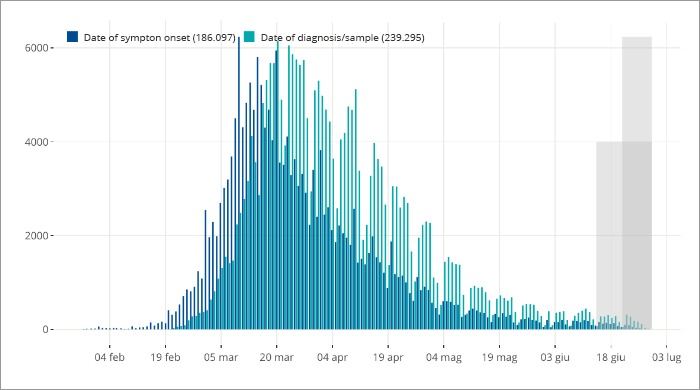Key Points
The overall picture of the transmission and impact of the SARS-CoV-2 infection in Italy remains one of a low level of criticality with a cumulative incidence of the 14 days from June 15 to 28 of 4.7 per 100,000 inhabitants (in decline), according to the weekly data on phase two of the coronavirus emergency prepared by the health ministry and the the Higher Health Institute (ISS).
The report regards the June 22-28, 2020 period, following the third phase of activity reopenings on June 3.
A slight decrease in the number of new diagnosed cases reported to the integrated surveillance system of the Higher Health Institute (ISS) was observed in the June 22-28, 2020 period with respect to the previous weekly monitoring report, with the national Rt number below 1. New cases of infection were reported throughout the peninsular, with an increase in cases in some regions and autonomous provinces with respect to the previous week of monitoring.
This is largely due to intense screening and investigation of cases, with the identification and monitoring of close contacts. Nevertheless, it is highlighted that the COVID-19 epidemic in Italy is not over.
The epidemiological situation remains extremely fluid. The Rt estimates tend to fluctuate in some regions and autonomous provinces with the outbreak of transmission hotspots that subsequently get brought under control.
Therefore, estimates above 1 are observed in regions where there have been recent outbreaks.
There continue to be no signs of care services being overwhelmed, although the number of reported cases remains high in some regions.
This calls for caution as it shows that, in some parts of the country, SARS-CoV-2 is still circulating at a significant level.
Conclusions
- Although the lockdown measures made it possible to effectively control SARS-CoV-2 infection across the national territory, widespread transmission of the virus continues when favourable conditions occur, causing outbreaks, including some of a significant size.
- The number of new cases of infection remains contained on the whole. This is thanks to testing-tracing-tracking activities,which make it possible to break potential transmission chains at an early stage.
- The reduction in the time between the start of symptoms and diagnosis/isolation makes faster identification and clinical care for the people who contract the infection possible.
- It is not surprising to observe a low number of cases that require hospitalization as, given the characteristics of the COVID-19 illness, only a small proportion of the total number of people who contract the SARS-CoV-2 virus go on to have a serious clinical situation.
- The situation with respect to the first half of June 2020 remains positive on the whole, with some small alarm signals regarding transmission.
At the moment, the data confirm that it is appropriate to maintain the prevention and control measures that have already been adopted.
It is also necessary to maintain a high level of resilience of the regional services, to continue to strengthen awareness among the population, to actively seek out and diagnose potential cases, to isolate confirmed cases and put close contacts into quarantine.
Fonte Salute.gov.it News
